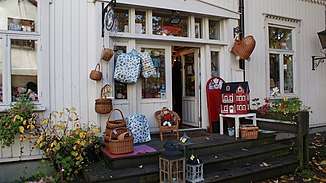Toy store
Notable examples
- Hamleys, the world’s largest toy shop
- Toys “R” Us, international company now Tru Kids
- FAO Schwarz, famous American brand and store
- The LEGO Store, official store for Legos
- Build-A-Bear Workshop has the concept of making your own stuffed toy
- Learning Express Toys, franchise of specialty toys
- Smyths Toys Superstores
History
The first toy store was founded in 1760 by William Hamley in London, under the name of “Noah’s Ark”, later renamed to Hamleys.[1] The famous toy store in New York City, FAO Schwarz, was founded under the name Schwarz Toy Bazaar. It was founded in 1862 by the German immigrant, Frederick August Otto Schwarz.[2] The former largest toy retailer in the United States, Toys “R” Us, started business in 1948 by Charles Lazarus, a veteran of World War II.[3] In 2015, FAO Schwarz closed, and did not reopen until after Toys “R” Us went bankrupt in 2018.[2]
Economics
Today, toy stores face competition from the online toy market. As a result, many large toy retailers have been rendered bankrupt. These competing websites include Amazon or eBay. Toys “R” Us cut prices in an attempt to compete, but it ultimately ended in failure.[3] As Jeff P. Bezos explained, "For a toy store to survive, they've got to create the kind of fun that Amazon can't." Toy Stores that adopt this model by increasing in-store interactivity have been more successful in maintaining business. Another model many stores have adopted is an online alternative, specifically for the individual retailer.[4]
Controversies
There can be a large gender bias for the marketing of certain products. This includes using color to market products to a certain gender, or only showing one gender to market to that specific demographic. On the U.S. Disney Store website, the toys for boys are predominantly red, black, brown, or grey, while the toys for girls are mostly pink or purple. However, the toys meant for both boys and girls were mostly of the same color palette as the toys for boys.[5]
References
- "The history of Hamleys". 2010-02-11. Retrieved 2019-03-25.
- Howland, Daphne. "FAO Schwarz returns to New York". Retail Dive. Retrieved 2019-03-25.
- Blakemore, Erin. "Inside the Rise and Fall of Toys 'R' Us". HISTORY. Retrieved 2019-03-25.
- https://www.facebook.com/abhabhattarai. "Why neighborhood toy stores are thriving while Toys R Us goes bankrupt". Washington Post. Retrieved 2019-03-25.
- Auster, Carol J.; Mansbach, Claire S. (2012). "The Gender Marketing of Toys: An Analysis of Color and Type of Toy on the Disney Store Website". Sex Roles. 67 (7–8): 375–388. doi:10.1007/s11199-012-0177-8. ISSN 0360-0025.
External links
| Wikimedia Commons has media related to Toy shops. |
- Inside Toyland: Working, Shopping, and Social Inequality, by Christine L. Williams, University of California Press, 2008.
